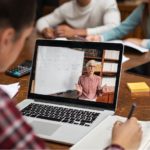As teachers across the country prepare to move our work online, I’ve been looking over previous posts that might offer practical guidance.
This post — from July of last year — asks a simple question: in online teaching, does pointing matter?
Happily, research by Richard Mayer points us in a useful direction.
You know, of course, that the right kind of movement can help students learn. The nascent field of “embodied cognition” works to explore the strategies that work most effectively.
Here’s a collection of resources.
And, here’s a recent blog post about kindergarteners moving to learn the number line.
You also know that online learners easily get distracted, often because they multitask. (I say “they” because you and I would never do such things.)
This recent post shows that even folding laundry — a harmless-seeming activity — reduces online learning.
What happens when we put these two research pools together?
Specifically: can movement reduce distraction, and increase learning, for online learners?
Benefits of Online Pointing?
Several researchers — including the estimable Richard Mayer — wanted to answer that question.
Specifically, they wanted to know: do pointing gestures made by the teacher help online students learn?
They had students watch an online lecture (about “neural transmission,” naturally).
For the first group of students, the teacher pointed at specific places on relevant diagrams.
For the second group, the teacher pointed generally toward the diagrams (but not at specific parts of them).
For the third, the teacher moved his hands about, without pointing specifically.
For the fourth, the teacher didn’t move his hands.
Do different pointing strategies help or hurt?
Benefits Indeed
Sure enough, pointing matters.
Students in the first group spent more time looking at the relevant parts of the diagrams.
They did better on a test that day.
And — most important — they did better than the other groups on a test a week later.
Now: a week isn’t exactly learning. We want our students to remember facts and concepts for months. (Preferably, forever.)
But, the fact that the memories had lasted a week suggests it’s MUCH likelier they’ll last longer still.
Practical Implications
If your classroom life includes online teaching, or teaching with videos, try to include specific pointing gestures to focus students on relevant information. At least with this student population, such gestures really helped.
By the way, this study doesn’t answer an interesting and important question: “does student movement as they watch online lectures help or hurt their learning?”
We know from the study cited above that irrelevant movement (like folding laundry) doesn’t help. But: should students mirror your gestures as they watch videos? Should you give them particular gestures to emulate?
We don’t know yet…but I hope future research helps us find an answer.




